
Original Link: https://www.anandtech.com/show/1525
Soltek K8TPro-939: Moving A64 to 939
by Wesley Fink on October 28, 2004 12:05 AM EST- Posted in
- Motherboards
Soltek is a company best known for excellent value in its motherboards. Value means delivering more than you might expect at a given price, and we have seen Soltek motherboards in the past, like the SL-75FRN2-RL, that deliver excellent features and great overclocking performance at a reasonable price. In fact, this nForce2 Ultra 400 board is still considered by some to be the best value available among Socket A motherboards.
With this value history, we were very interested in taking the new Socket 939 SL-K8TPro-939 for a spin. There is not exactly a deluge of 939 boards on the market, though that is improving. So, the prospect of a new 939 board from a company that delivers outstanding value seems like a good thing. While Soltek has been handicapped in the US by the lack of a US distributor, it certainly looks like their relationship with NewEgg has made up for this problem. You can't find Soltek motherboards widely distributed, but you can find them at the largest on-line reseller. We suspect that this generates enough US volume that Soltek must wonder what the real value of a US distributor would be.
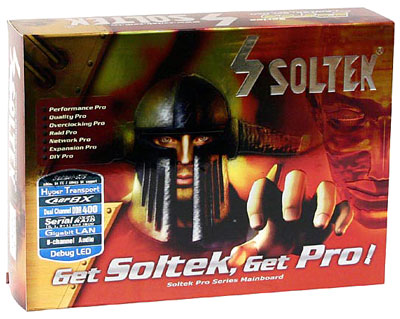
While Soltek is best known for low-cost boards, the K8TPro-939 is part of their higher-end PRO series. It is as full-featured as any VIA K8T800 Pro board that you will find for Socket 939 Athlon 64, but pricing falls to the low end of the full-featured boards. In fact, the current price of $114 might make you think that you are looking at a more stripped 939 board. That is not the case, as you will find the Soltek loaded with features.
Basic Features: Soltek K8TPro-939
| Soltek SL-K8TPro-939 Motherboard Specifications | |
| CPU Interface | Socket 939 Athlon 64 |
| Chipset | VIA K8T800 Pro/VT8237 |
| Bus Speeds | 200MHz to 300MHz (in 1MHz increments) |
| PCI/AGP Speeds | Asynchronous (Fixed) or Float |
| Core Voltage | 0.8V to 1.7V, 0.025V increments to 1.5V, 0.05V increments 1.5V to 1.7V |
| DRAM Voltage | Default, 2.6V to 2.8V in 0.1V increments |
| AGP Voltage | Default, 1.5V-1.8V in 0.1V increments |
| 2.5V (VDD) Voltage | Default, 2.5V-2.8V in 0.1V increments |
| Hyper Transport Ratios | 1x to 5x in 1X increments |
| CPU Ratios | Auto, 4x to 20x in 1X increments |
| DRAM Speeds | Auto, 100, 133, 166, 200 |
| Memory Command Rate | Auto, 1T, 2T |
| Memory Slots | Four 184-pin DDR Dual-Channel Slots Unbuffered Non-ECC Memory to 4GB Total |
| Expansion Slots | 1 AGP 8X Slot 5 PCI Slots |
| Onboard SATA | 2-Drive SATA by VIA VT8237 PLUS 2-Drive SATA by PDC20579 |
| Onboard IDE | Two Standard VIA ATA133/100/66 (4 drives) Promise PDC20579 (2 Drives) |
| SATA/IDE RAID | 2-Drive VIA SATA RAID plus 2-Drive Promise SATA RAID plus 2-Drive Promise IDE RAID. RAID 0, 1, JBOD |
| Onboard USB 2.0/IEEE-1394 | 8 USB 2.0 ports supported VIA VT8237 2 1394A FireWire ports by VIA VT6307 |
| Onboard LAN | 1 Gigabit Ethernet by VIA VT6122 |
| Onboard Audio | Realtek ALC850 AC'97 2.3 8-Channel with UAJ, SPDIF optical in and out |
| BIOS | Award K8939FAE Beta 10/26/2004 |
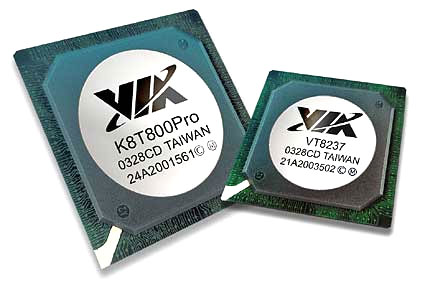
The K8TPro-939 is powered by VIA's dual chip K8T800 Pro North Bridge and the VIA VT8237 South Bridge. For more information on this chipset, you can refer to our launch article for the chipset:
VIA K8T800 PRO: PCI/AGP Lock and 1000 HyperTransport for Athlon 64
The K8T800 Pro is targeted at both Socket 939 and Socket 754, and it provides 1000 HT speed to all current Athlon 64 sockets. This contrasts to nVidia's nForce3-250 family, which has both 800 HT and 1000 HT versions depending on the target board.
The Soltek SL-K8TPro-939 includes:
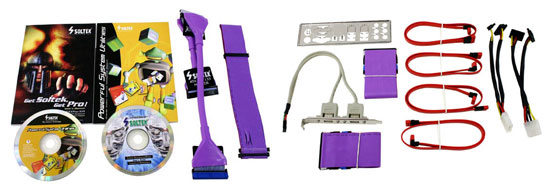
- One round purple IDE cable color-coded to the black Soltek motherboard with purple slots
- Two matching purple flat IDE cables
- One matching purple flat floppy cable
- Four Serial ATA data cables
- Two Serial ATA power splitters supporting 4 SATA power connectors
- One USB bracket with 2 ports
- Quick Start Installation Guide
- Manuals for both the Motherboard and System Utilites
- Two CDs with Motherboard Drivers and Bonus CD with PC-Cillin 2004, Virtual Drive 7, RestoreIT! 3 Lite, Partition Magic 6.0 SE, and DriveImage 4.0
- Promise PDC20579 Driver diskette
- I/O shield
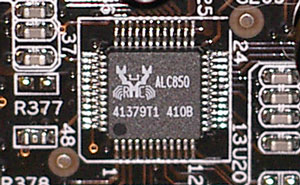
The Realtek ALC850 7.1 audio chip is appearing on many recent motherboards. This 8-channel audio codec is fully AC '97 2.3 compliant and features 16-bit 8-channel audio and auto-jack sensing with support for a full range of analog and digital IO. The ALC850 includes both Optical SPDIF in and out connectors on the rear IO panel.
The ALC850 Codec provides four pairs of stereo outputs, with 5-Bit volume controls and multiple stereo and mono inputs, along with flexible mixing, and gain and mute functions. Two 50mW/20ohm headset audio amplifiers are integrated at Front-Out and Surround-Out, and both amplifiers are selectable for Front-Out, Line-In and Mic-In as a Universal Audio Jack.
The real question here is why Soltek chose the Realtek codec instead of the excellent VIA Envy codec. We suspect that the answer has to do with the cost difference between the VIA and Realtek solutions.
You can find more information on the recently released ALC850 at Realtek.

Soltek provides a full selection of rear I/O ports. These include 6 programmable audio mini jacks plus optical SPDIF in and out connectors to support the Realtek ALC850. The back panel also includes PS2 mouse and keyboard, parallel, 1 serial, 1 standard Firewire (IEEE1394a), 4 USB, and a Gigabit Ethernet. There is no rear port for a Parallel Printer, but there is an onboard header for an optional parallel printer add-on cable.
The K8TPro-939 supports two SATA connectors driven by the VIA Southbridge. These 2 ports can be combined in Raid.
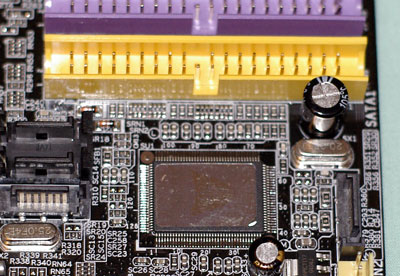
Soltek also supplies a Promise controller that supports two additional SATA drives and 2 more IDE drives. Drives can be configured as RAID on the Promise, but they cannot be combined in a RAID with the VIA drives.
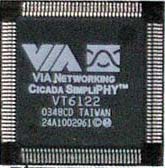
Gigabit LAN is provided by the VIA VT6122. While the LAN is specified as 1 Gigabit, it is controlled by the PCI bus, which can limit throughput severely in some situations. Internet users will not see a slow-down, and generally, this will not make much (if any) difference in real-world performance. However, file transfers and gaming over a 1 Gigabit LAN will likely be slower on a Gigabit LAN on the PCI bus.
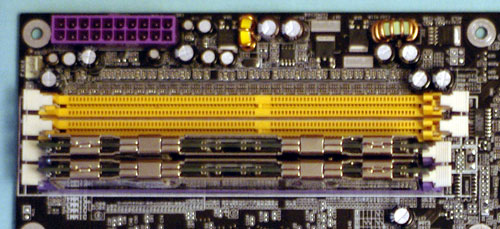
Four DIMM slots support up to 4GB of up to DDR400 memory in a Dual-Channel memory configuration. Dual-Channel 1 is DIMMs 1 and 2, and Dual-Channel 2 is DIMMs 3 and 4. Soltek also states that a single DIMM in slots 2 or 4, or a pair of DIMMs in 2+4 are non-bootable memory configurations.
Board Layout: Soltek K8TPro-939
Recent Soltek Pro boards have sported black and purple as their color scheme. The K8TPro-939 continues that design with a black board, purple slots, and coordinating purple cables.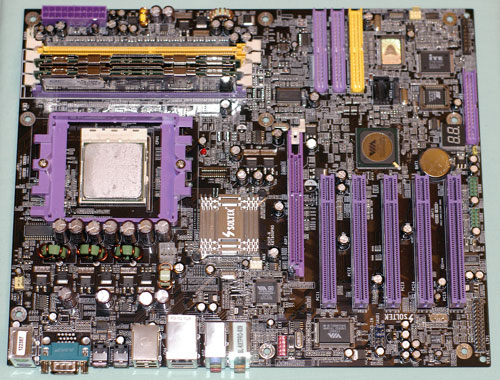
The basic layout of the Soltek is excellent, better than most recent 939 boards that we have evaluated.
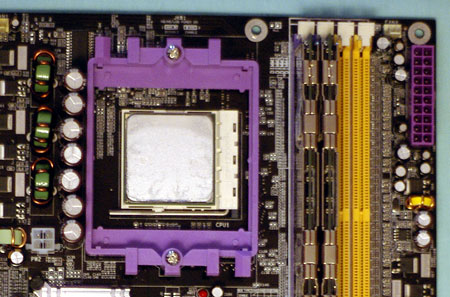
The ATX 20-pin and the 4-pin 12V connector are in near ideal locations on the K8TPro-939. The bulky 20-pin ATX is located on the preferred top right edge of the motherboard. This location on the board edge rarely interferes with processor air flow. The 4-pin 12V is also best on the upper right edge, but on the Soltek, the 4-pin power connector is placed between the CPU and IO ports. While this cable is smaller, it still needs to be routed past the CPU with care. This is not a great location for the 12V, but we had no real issues in our case setup. A better location would have been the top board edge or upper right board edge. Soltek did get the bulky 20-pin out of the way and that is more than what many designs do.
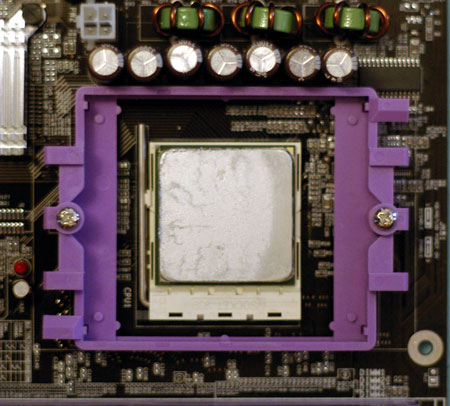
The CPU socket is in the top center of the board. PCI slots are below the socket and memory is to the right of the CPU. There is plenty of room around the Socket 939, so most Heatsink/Fans should work fine. The only possible problem is the tall capacitors that line the left edge of the socket, which may interfere with large spread HSF designs.
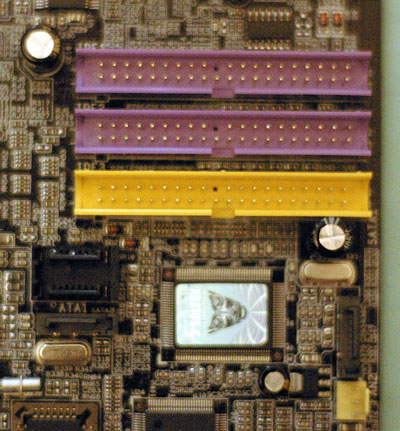
The IDE connectors are in our preferred right edge of the motherboard, but they are below mid-line where they may be a reach in a full tower case design. Most case designs will have no issue with this location, however. The four SATA connectors are in the same area and they should be an easy set up. The only potential problem with the SATA location is that the long PCU cards in PCI slot 3 may be a tight fit with SATA drives connected.
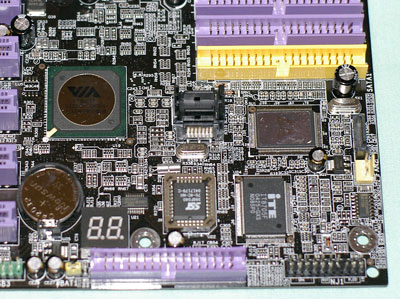
The floppy connector is the only glaring fault in an otherwise decent layout. The location at the bottom right edge of the motherboard is terrible, and is a very long reach in most any case. In a full tower case, you will have to find a super long floppy cable to reach this location. Since many users no longer even use a floppy drive, this won't matter to them, but if a floppy drive is still part of your build, this location will be a challenge in some cases.
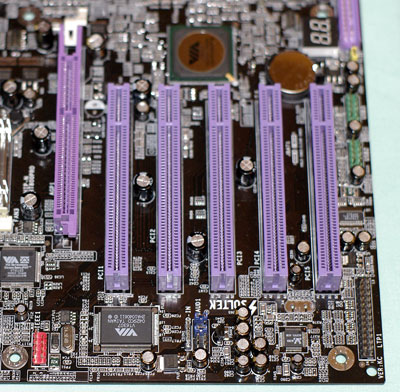
The Soltek arrangement for the AGP and 5 PCI slots is pretty standard. With most users skipping over the slot next to the VGA card for better cooling, this leaves 4 usable PCI slots. With a standard-width video card, you could use slot 5 in a pinch.
The option headers are mostly lined up at the bottom of the board edge, an out-of-the-way location. The audio connectors are an exception, located in the middle of the PCI slots. If you still use or need audio cables, you will have to be careful routing them in this busy area. A better location would have been above the PCI slots.
BIOS: Soltek K8TPro-939

Soltek uses Phoenix-Award BIOS, which will be a familiar interface for most users.
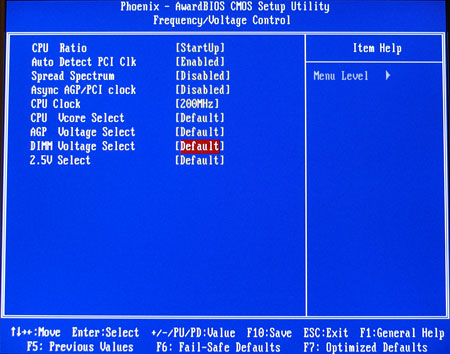
Most of the options of interest to overclockers are contained in the Frequency/Voltage Control menu. This includes CPU speed, AGP Asynchronous (Fixed) select, CPU ratios, and CPU/DIMM/AGP/VDD (2.5V) voltage.
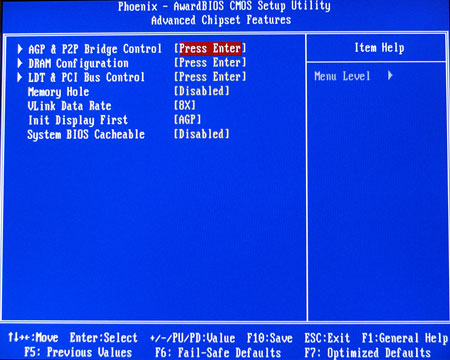
The enthusiast settings not found in Frequency/Voltage Control can be found in Advanced Chipset Featrures. HT ratios to 1 GHz are available in the LDT & PCI Bus Control submenu.
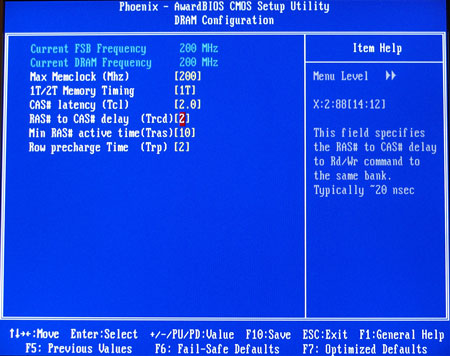
The DRAM Configuration submenu contains a full range of memory settings. The shipping K8TPro-939 BIOS had adjustments for just CAS timings, while the 10/26 Beta BIOS added a complete selection of memory adjustments.
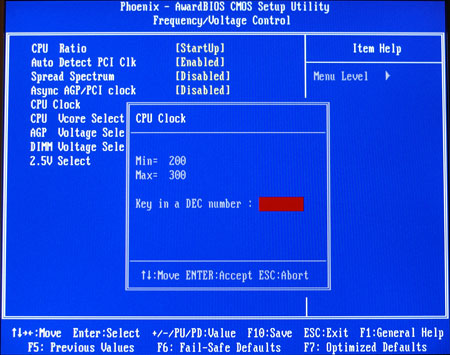
The CPU can be adjusted over an adequate, if not exciting, speed range from 200MHz to 300MHz in 1MHz increments. We prefer a wider range on Athlon 64 boards, since the A64 allows choosing lower CPU ratios. However, as you will see in overclocking, the adjustment range is a moot point in the current Soltek design.
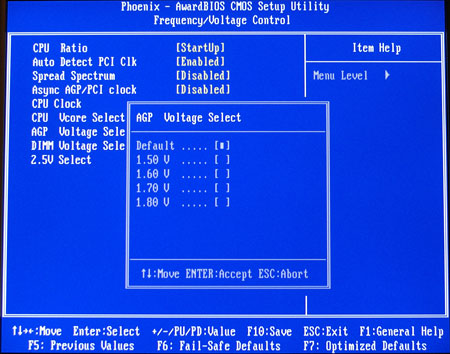
The Asynchronous AGP/PCI Clock can be set to Enabled (fixed 66 AGP/PCI frequency) or Disabled. Unfortunately, as you will see in the OC pages, this function does not appear to work in the Soltek BIOS that we tested.
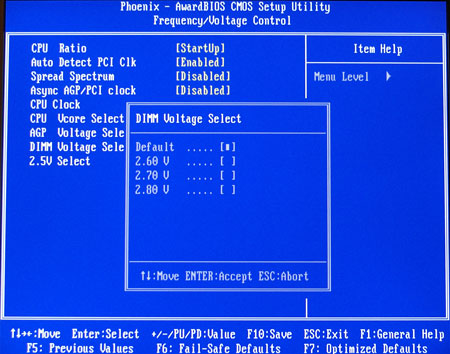
Memory Voltage can be adjusted to 2.8V, which is OK. A range to 3.0V to 3.2V would have been much more useful for those who push the performance of their system.
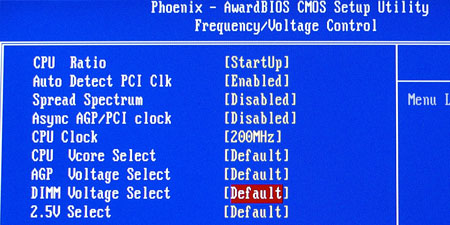
The other part of high FSB clocking is CPU ratios or multipliers. The Soltek provides a wide range of 4X to 20X, with adjustments in whole multipliers only. Keep in mind that while all Athlon 64 chips can be downclocked with lower ratios, only the FX chips are completely unlocked and can be set to higher than stock ratios. We confirmed that the ratios do work as they should on the K8TPro-939 board.
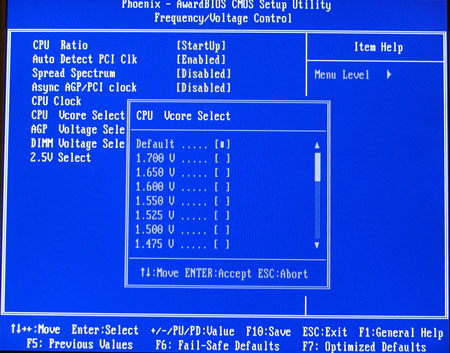
vCore can be widely adjusted from 0.8V to 1.7V. This should satisfy all, but the most aggressive phase-change overclockers.
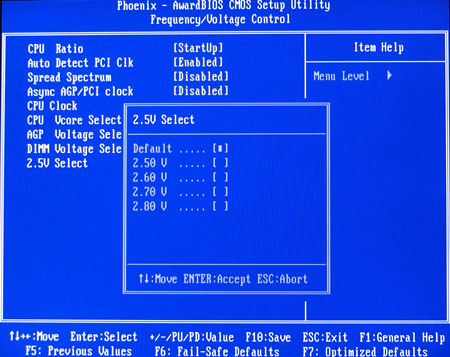
VDD voltage can be adjusted from the default 2.5V up to 2.8V.
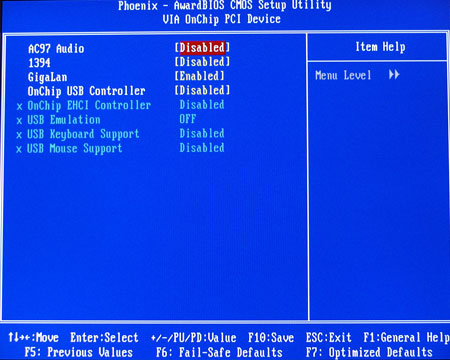
With all of the integrated features of the K8TPro-939, you will spend a lot of time in the Integrated Peripherals menu.
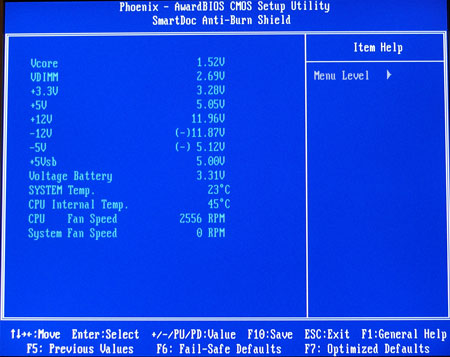
Soltek calls their PC Health function SmartDoc Anti-Burn Shield. Here, you can monitor fan speeds and voltages. For those interested in the AMD K8 Cool'n'Quiet, the adjustments can be found in the Power Management Setup menu.
Tech Support and RMA: Soltek K8TPro-939
Our support evaluation procedure tries to determine the responsiveness of manufacturers to Technical Support problems. Our procedure is as follows:The way our Tech Support evaluation works is first, we anonymously email the manufacturer's tech support address(es), obviously not using our AnandTech mail server to avoid any sort of preferential treatment. Our emails (we can and will send more than one just to make sure we're not getting the staff on an "off" day) all contain fixable problems that we've had with our motherboard. We allow the manufacturer up to 3 business days to respond, and then we will report whether or not they responded within the time allotted, and if they were successful in fixing our problems. In case we don't receive a response before the review is published, any future responses will be added to the review, including the total time it took for the manufacturer to respond to our requests.
The idea here is to encourage manufacturers to improve their technical support as well as provide new criteria upon which to base your motherboard purchasing decisions. As motherboards become more similar everyday, we have to help separate the boys from the men in as many ways as possible. As usual, we're interested in your feedback on this and other parts of our reviews, so please do email us with your comments.
No matter whether you are accessing the Soltek USA site or the Global Site in Taiwan, the Soltek access is excruciatingly slow. This makes simple things like finding a BIOS update or Technical Support information tedious. Soltek really needs to improve response times to their website, as their current, slow site says nothing positive about the company.
We still cannot find Soltek's RMA policy on the Soltek webite. Soltek lists sales/support operations in Taiwan, Europe, and South America, but there are no listings for offices in the USA. Soltek tells us that RMA requests should be directed toward the dealer who sold you the board. In the event of problems there, requests can be addressed to [email protected]. The lack of an identifiable US office for Soltek is of concern, but we should also point out that our requests to their Taiwan headquarters were all answered promptly, and the Soltek staff was very helpful. FAQ's, downloads, and product information are available at the main site - you will be linked to this main site if you visit www.soltekusa.com. Since NewEgg is a major vendor for Soltek in the USA, you might also take a closer look at the NewEgg RMA and refund policy for Soltek motherboards.
Technical Support is also available by email, which is listed under "Contacts" at the main site. Soltek's tech support response time met our response requirements, with an answer from Soltek Taiwan just 28 hours after our original email. The reply from the technical support representative was helpful and the advice given was useful and appropriate to the problem. In 4 Soltek reviews, the last 3 replies showed good technical grasp of our question, so it looks like Soltek Technical Support is improving in quality. The fast response times by Soltek in all 4 requests left a very positive impression of Soltek's commitment to customer satisfaction.
We reiterate our past advice regarding Soltek. With no US office, those who cannot find a local Soltek resource should send their Tech Support inquiries to the main site in Taiwan. If our experience is any indication, you will be pleased at the responsiveness that you will find in your contacts with Soltek.
FSB Overclocking: Soltek K8TPro-939
While Soltek is best known for delivering good value, part of that value equation has always been the outstanding overclocking capabilities of Soltek boards. For that reason, we expected a lot from the Soltek overclocking tests. As you will see, we had very mixed results.Front Side Bus Overclocking Testbed
| Front Side Bus Overclocking Testbed | |
| Default Voltage | |
| Processor: | Athlon 64 FX53 2.4GHz |
| CPU Voltage: | 1.5V (default) |
| Cooling: | Thermaltake Silent Boost K8 Heatsink/Fan |
| Power Supply: | OCZ Power Stream 520W |
| Memory: | OCZ PC3200 EL Platinum Rev. 2 OR Geil PC3200 Ultra X |
| Hard Drive: | Seagate 120MB PATA (IDE) 8MB Cache |
| Maximum OC: (Standard Ratio) |
204x13 220x12 2651MHz (+10.5%) |
| Maximum FSB: (Lower Ratio) |
228 x 9,10,or 11 (2508MHz) (1:1 Memory, 2 DIMMs in DC mode) |
The Soltek did a good job with Standard Ratio overclocking, reaching our highest previous overclock at 220x12 or 2651MHz. However, no matter what lower ratio we chose, the highest CPU clock setting that we could achieve with stability was 228. SATA was not an issue here, since our test bed was running an IDE Hard Drive. All tests were run with the Asynchronous PCI/AGP set to Enabled to fix the frequency.
To try to find the answer to these low clock frequencies, we decided to try to run the K8TPro-939 with the Asynchronous PCI/AGP disabled. Without a PCI/AGP lock, we reached the same 228 frequency as our top stable setting. We can only conclude that the AGP/PCI lock is not working on this Soltek board. Since we have tested several recent VIA K8T800 Pro motherboards that definitely have working AGP/PCI locks, we suspect that the problem is with the Soltek BIOS or design.
It is very disappointing to find such limited frequency capabilities on the Soltek board. With other Socket 939 motherboards reaching 275 to 290 with the Athlon 64, 228 is a very poor performance. The Soltek is, otherwise, a very capable overclocker, matching the best that we have seen with this CPU at stock frequencies.
Front Side Bus Stress Test Results:
As part of our overclocking tests, a full range of stress tests and benchmarks were run to ensure that the Soltek K8TPro-939 was stable at each overclocked speed. This included Prime95 torture tests, and the addition of other tasks - data compression, various DX8 and DX9 games, and apps like Word and Excel - while Prime95 was running in the background. 228MHz was the highest overclock that we were able to achieve with the Soltek while running these tests at default ratio and default voltage. This matches the best stock overclock with this FX53 processor.Memory Stress Testing: Soltek K8TPro-939
The memory stress test is very basic. It tests the ability of the Soltek K8TPro-939 to operate at its officially supported memory frequency (400MHz DDR), at the lowest memory timings that OCZ PC3200 Platinum Rev. 2 modules will support. All DIMMs used for stress testing were 512MB double-sided (or double-bank) memory. Memory was only tested in Dual-Channel mode using either one dual-channel (2 DIMMs) or 2 dual-channels (4 DIMMs).| Stable DDR400 Timings - One Dual-Channel (2/4 DIMMs populated) |
|
| Clock Speed: | 200MHz |
| CAS Latency: | 2.0 |
| RAS to CAS Delay: | 2T |
| RAS Precharge: | 10T* |
| Precharge Delay: | 2T |
| Command Rate: | 1T |
Using two DIMMs in Dual-Channel 128-bit mode, the memory performed in all benchmarks at the fastest 2-2-2-10 timings, at 2.6V.
| Stable DDR400 Timings - Two Dual-Channel (4/4 DIMMs populated) |
|
| Clock Speed: | 166MHz |
| CAS Latency: | 2.0 |
| RAS to CAS Delay: | 2T |
| RAS Precharge: | 10T* |
| Precharge Delay: | 2T |
| Command Rate: | 2T |
Tests with the Soltek 939 with all four DIMM slots populated were a disappointment. Since every 939 board that we tested in our 939 roundup ran at DDR400 with 4 DIMMs, we have been very surprised to find some 939 boards that will not do DDR400 with 4 DIMMs. The Epox 9NDA3+ wouldn't do it, and now, neither will the Soltek. No matter what we set, the Soltek forced DDR333 with 4 DIMMs at 2T Command Rate. No matter what memory speed we set in the BIOS, the Soltek forced DDR333 with 4 DIMMs at 2T Command Rate. We also tried 1T Command Rate, and with 1T, the board set DDR200, no matter what we set in BIOS.
Until we see a BIOS update that corrects this issue, if you plan to run four DDR400 DIMMs, then you should choose another Socket 939 motherboard.
Performance Test Configuration: Soltek K8TPro-939
If you are interested in more information comparing the Athlon 64, Athlon 64 FX, LGA 775 Prescott, P4, and P4EE, please see our in-depth comparisons in the following reviews:AMD Athlon 64 4000+ & FX-55: A Thorough Investigation
nForce4: PCI Express and SLI for Athlon 64
.09 Athlon 64: Value, Speed and Overclocking
AMD Sempron: A Fresh Take on Budget Computing
Intel's 925X & LGA-775: Are Prescott 3.6 and PCI Express Graphics any Faster?
Intel 925X/915: Chipset Performance & DDR2
Intel Celeron D: New, Improved & Exceeds Expectations
Socket 939 Chipsets: Motherboard Performance & PCI/AGP Locks
AMD Athlon 64 3800+ and FX-53: The First 939 CPUs
The Athlon 64 FX-53: AMD's Next Enthusiast Part
Intel's Pentium 4 E: Prescott Arrives with Luggage
Athlon64 3400+: Part 2
AMD's Athlon 64 3400+: Death of the FX-51
Athlon64 3000+: 64-bit at Half the Price
| Performance Test Configuration | |
| Processor(s): | AMD Athlon 64 FX53 (2.4GHz) Socket 939 |
| RAM: | 2 x 512MB OCZ PC3200 Platinum Rev. 2 2 x 512MB Mushkin PC3500 Level II 2 x 512MB OCZ PC3500 Platinum Ltd |
| Hard Drive(s): | Seagate 120GB 7200RPM IDE (8MB Buffer) |
| Video AGP & IDE Bus Master Drivers: | VIA 4in1 Hyperion 4.51 (12-02-2003) nVidia nForce 6.11 Beta (nForce4) nVidia nForce Platform Driver 4.24 (nForce3 Ultra) |
| Video Card(s): | nVidia 6800 Ultra (AGP 8X) nVidia 6800 Ultra (PCI Express) |
| Video Drivers: | nVidia nForce 61.77 (VIA K8T-P, nF3 Ultra, Intel 925X) nVidia nForce 61.81 Beta (nForce4) |
| Operation System(s): | Windows XP Professional SP1 |
| Motherboards: | Soltek K8TPro-939 (VIA K8T800 PRO) Epox 9NDA3+ (nForce3 Ultra) nVidia nForce4 Ultra Reference Board Abit AV8 PRO (VIA K8T800 PRO) ECS KV2 Extreme (VIA K8T800 PRO) Gigabyte K8NSNXP-939 (nVidia nForce3 Ultra) MSI K8N Neo2 (nVidia nForce3 Ultra) MSI K8T Neo2 (VIA K8T800 PRO) |
Tests used OCZ PC3200 Platinum Rev. 2, which uses Samsung TCCD chips. Earlier 939 benchmarks used Mushkin PC3500 Level II or OCZ PC3500 Platinum Ltd, which were both based on Winbond BH5 memory chips. BH5 memory has been discontinued and is no longer available. All memory ran at 2-2-2-10 timings in all benchmarks.
Since the nVidia 6800 Ultra AGP was used for testing in the 939 chipset launch, we used the 6800 Ultra AGP for benchmarking the Soltek K8TPro-939. The PCI Express 6800 Ultra was used for all testing with the nForce4 and the Reference Intel 925X. Resolution in all benchmarks is 1024x768x32 unless otherwise noted.
Results for VIA K8T800 Pro based motherboards are in green in our results. The Soltek K8TPro-939 we are testing is color-coded in dark green. nVidia nForce3 Ultra based boards results are orange, with the nF4 Ultra results in red. Intel 925X results are in blue. Intel results are included for Reference only. The color coding should allow easy comparison of the tested Soltek to other VIA chipset results and to other chipsets and processors.
General Performance and Encoding




We first saw the pattern of nVidia higher Winstone results with the nForce3 Ultra in our Socket 939 roundup. The Soltek repeats the same pattern of about 3 points lower in performance by VIA K8T800 Pro, in both Business Winstone and Content Creation Winstone. All comparisons used the nVidia 6800 Ultra in Benchmark testing.
It is interesting that the Soltek K8TPro-939 is the fastest 939 board that we have tested in both AutoGK Encoding and PCMark 2004. Both results indicate that the Soltek has been tweaked very effectively for stock performance.
DX9 Gaming Performance






The Soltek is very fast in DirectX 9 games. It is also the first VIA board to match the performance of the nForce 3 Ultra boards in Halo. The only exception in DX9 is the very average performance in UT2004, which requires DX9.0b to run, but may not really be a DX9 game.
DX8 and OpenGL Gaming Performance






The K8TPro-939 continues top-notch gaming performance at stock speeds in DX8 and Open GL games. The Soltek design is proving to be very effective in stock gaming. If Soltek can fix the overclocking issues, the Soltek will be a favorite of many Athlon 64 gamers.
Workstation Performance






The Soltek K8TPro-939 is one of the top 939 boards in just about every SPECviewperf test. Unfortunately for Soltek, this excellent Workstation performance is offset by the lower memory speed required for 4 DIMMs. Workstations usually want all the memory that you can give them, so you will rarely see workstations running just 2 DIMMs. If Soltek can fix the problem with reduced speed at 4 DIMMs, the Soltek could be a decent choice among 939 boards in this performance-intensive market segment.
Final Words
It is really good to see more Socket 939 motherboards appearing in the market just in time to house the new, lower-priced 90nm 939 processors. The recently reviewed Epox 9NDA3+ and this Soltek K8TPro-939 both add new 939 choices and good value to those new choices. This Soltek board costs about the same as the value 939 boards, but it offers a full set of features that compares well to any Socket 939 board. It is also a very fast performer at stock speeds, performing as well or better than any VIA K8T800 Pro motherboard that we have tested.However, the broken PCI/AGP frequency lock on the Soltek makes it a poor choice to get the most from the new 3000+, 3200+, or 3500+ Socket 939 processors. We saw in our recent review of the new 90nm processors that most could reach 2.6GHz with not much effort. With 2.6GHz as a target, it is easy to see that we would need a 289 setting for the 3500+, 260 for the 3200+, and 236 for the 3500+. With the AMD + Series locked at the top, the only 90nm that could come close to 2.6GHz on the Soltek would be the 3500+, which, at 228 x11, could reach 2.51 Ghz. There is no such issue with the FX processors, since they are unlocked up or down, but frankly, they are very expensive and the end-user is not likely to be looking for a value Soltek to use with an $800 CPU.
The other issue with the Soltek is that 4 double-sided DIMMs will not run at DDR400, as the Soltek resets the memory speed to DDR333 at 2T. If you need to use 4 DIMMs at DDR400, then look elsewhere until Soltek fixes this problem.
Both of these issues are very disturbing with the Soltek board because it is full of features and a great performer at stock speeds. It does not suffer from any reboot issues and is exceptionally stable at stock speeds and any setting up to 228. If Soltek can correct the broken lock and 4 DIMM problems with a BIOS update, the Soltek would be one of the fastest and most stable 939 boards that we have tested; but the warts are too large with the current BIOS to recommend, if you require 4 DIMMs or robust overclocking.
The Soltek is a fast, stable 939 board at stock speeds with 2 DIMMs. If that is what you are looking for, the Soltek is a great value. We hope that Soltek will fix the issues in the current BIOS. If they do, we will report that here in an update. To Soltek, we would say, fix the BIOS and this board will be a winner. An excellent alternative with the same K8T800 Pro chipset, a working PCI/AGP lock, top performance with 4 DIMMs, and similar price is the Abit AV8. It is not as full-featured as the Soltek, but everything works as it should. We found that the working AGP/PCI lock allowed us to reach a clock frequency of 280 in our Abit AV8 overclocking tests. At a higher price, the Asus A8V is also an excellent choice based on the same VIA chipset that reached 289 in our overclocking test bed.







